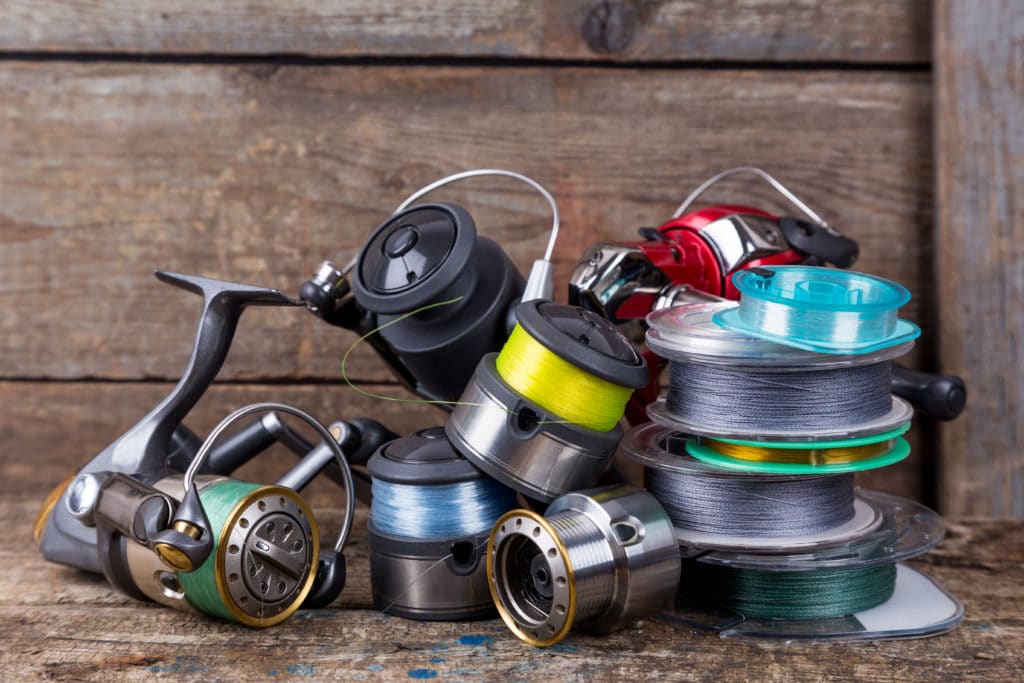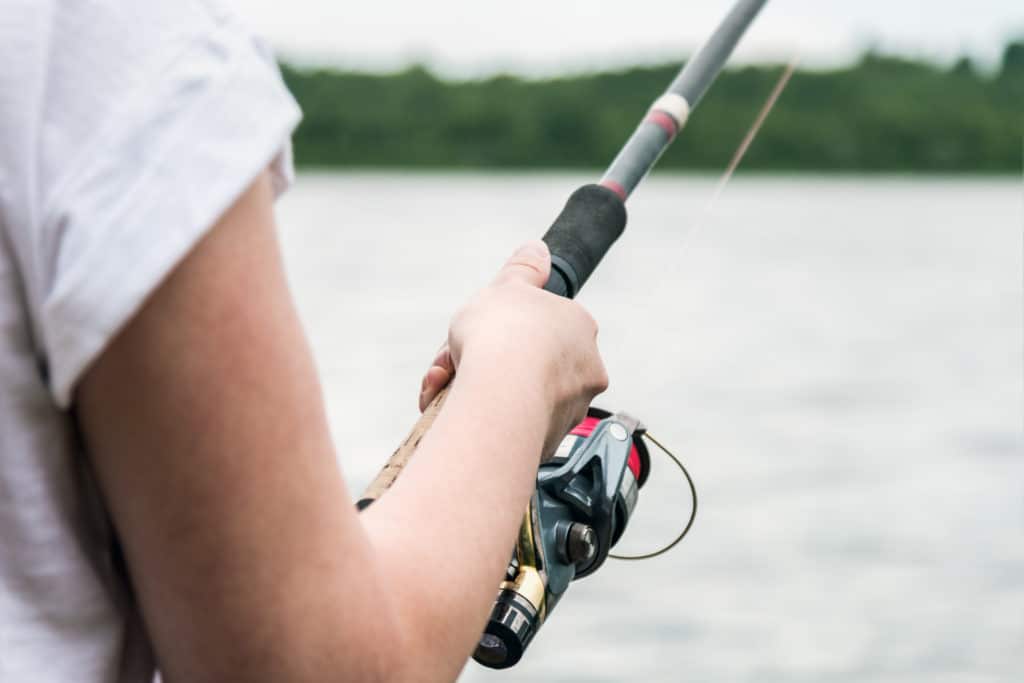Many anglers believe, with good reason, that the Palomar knot is the best fishing knot.
When tied properly, the knot comes close to being a 100% knot.
Its double line makes it efficient at maintaining a high breaking strength.
It is one of the most reliable fishing knots and it’s quite easy to tie.
The Palomar knot is also loved for its versatility, as anglers can use it with braided, monofilament, and fluorocarbon lines alike.
Below, we are going to take a look at whether the Palomar knot is good for fluorocarbon, or if you should choose a different option.

Contents
What is the Palomar Knot, and How do You Tie it?
The Palomar knot attaches a fishing line to a hook, swivel, snap, and fly to a leader or tippet.
It is a popular knot among anglers, and the tying process is easy.
The Palomar knot works well for most lines, but it’s best with braids.
Here are the knot efficiency numbers of the knot when tested on the different fishing lines:
- Monofilament – 115.8%
- Fluorocarbon – 100.7%
- Braid – 124.0%
On average, the Palomar knot has a knot efficiency of 113.5%, making it one of the best knots known to anglers.

How to Tie It
The process of trying the knot is straightforward. Follow these steps:
- Double about 6 inches of the tag end of the line. Just fold the tag end towards the fixed-line.
- Thread the doubled line through your hook’s eye. You want the point pointing to the opposite side from where the line is coming from.
- Pass about 4 to 6 inches of the line.
- Make a loose overhand knot on the doubled line. The hook should remain in the middle.
- Pass the rest of the loop through the bend. Keep pulling until the loop passes to the other side of the hook.
- Lubricate the line before tightening. You can wet the line with water or saliva.
- Tighten the knot by pulling the standing line. You may grab the gap with your fingers to avoid being pierced by the hook. Tighten until you get the Palomar knot.
Ensure the knot is on the hook’s eye and not the shank when tightening. Tightening the final knot on the shank will limit the hook’s mobility. Also, if the final knot is on the shank, a fish will find it easier to bite through the knot.
Pros and Cons of the Palomar Knot
The popularity of the Palomar knot is well-deserved. And tying the knot is a skill every angler should have. Like almost everything on earth, the Palomar knot has advantages and disadvantages.
Pros
- Works well for monofilament, braided, and fluorocarbon lines.
- It is very reliable.
- Retains almost 100% of the original line-breaking strength.
- It is almost impossible to get loosed when tied perfectly.
- Can be used to bound two lines.
- Has a non-jamming release.
Cons
- Threading the hook can be difficult if the eye is too small.
- Bigger hooks require more line to pass through the eye. Getting it right in one try will take some practice.
- Passing the hook or fly through the loop can be awkward while tying the knot.
- It is not suited for making hair rigs.
- When using a heavy line, tying this knot requires plenty of pulling.
Other Popular Knots
There are various fishing knots, and each one has its pros and cons.
Depending on your fishing line and personal preference, you can choose a fishing knot to suit you.
Here are some other fishing knots:
Fisherman’s Knot
This knot’s original name was the improved clinch knot.
Over time, anglers started calling it the Fisherman’s knot, and the name stuck.
The Fisherman’s knot is an easy yet reliable knot. It’s great at withstanding tension and is a great choice for beginners.
The knot can be used to secure hooks, swivels, and lures to the fishing line.
Trilene Knot
The Trilene knot is a reliable knot considered a stronger version of the Fisherman’s knot.
It was developed specifically for use with monofilament lines.
It’s excellent for joining leaders, swivels, and lures to monofilament and fluorocarbon fishing lines.
Hangman’s Knots
This is one of the most versatile fishing knots. It is sometimes referred to as a uni knot, Grinner knot, and a Duncan loop.
Tying this knot is a skill that seasoned anglers and beginners alike should have.
It can be used in different ways, from attaching your line to the reel to using it to fox a lure or hook.
The tying process is similar to that of the Fisherman’s knot. One major difference is that you can use this knot for braided lines.
Snell Knot
A Snell knot comes in handy when using a blind or eyeless hook.
Anglers can also use it on hooks with eyes.
A Snell knot makes a good duo with monofilament, braided, and fluorocarbon lines.
This knot is particularly different from other fishing knots in that when the final knot is tied, it rests on the shank and not the hook’s eye.
San Diego Jam Knot
Although the San Diego Jam knot is more complicated than most fishing knots, learning how to tie it will be an amazing addition to your skillset.
This knot is also referred to as the reverse clinch knot and Heiliger and is popularly used among tuna fishers.
The knot is sturdy and reliable. However, the mobility of the hook or lure is limited by the tight grasp of the knot.
Is Palomar Knot Good for Fluorocarbon Line?
There are various knots, but not every knot will suit the available fishing lines.
Fluorocarbon can easily break if the proper knot is not used.
The line is loved for its sensitivity, which results from it being made of a harder material, unlike nylon monofilament.
However, the same hardness that increases its sensitivity can cause it to cut itself faster than other lines.
Using a Palomar knot with fluorocarbon fishing lines is great, but it cuts when the line is crossed, and anglers experience break-offs.
It can be a quite effective knot for fluorocarbon lines when the Palomar knot is tied properly.
The knot resists slipping and therefore doesn’t move down the line as much.
Tips to Avoid Palomar Knot Failure
To have a great fishing experience using the Palomar knot, you need to tie it properly.
Tying the knot incorrectly will result in a bad fishing experience.
Here are some tips on how to avoid a Palomar knot failure:
- Don’t cross the line. Crossing a fluorocarbon line on itself will cause it to cut into itself on the hookset.
- Always wet the line before clinching the knot tight. This is particularly crucial when you’re using a monofilament or fluorocarbon line.
- Avoid pinching the line together to run it through the hook eye.
- When cinching the line down tight, only pull the tag end. Avoid pulling the tag end and the mainline at the same time.
- Try not to burn the line.
Final Thoughts
There are great knots you can add to your skillset as an angler, and the Palomar knot is one of them.
The perfect knot doesn’t exist, but you can pair great knots with the right fishing lines and get superb results.
Tying a Palomar knot is straightforward.
And using it with a fluorocarbon line is a great idea as long as you’re tying the knot correctly.







